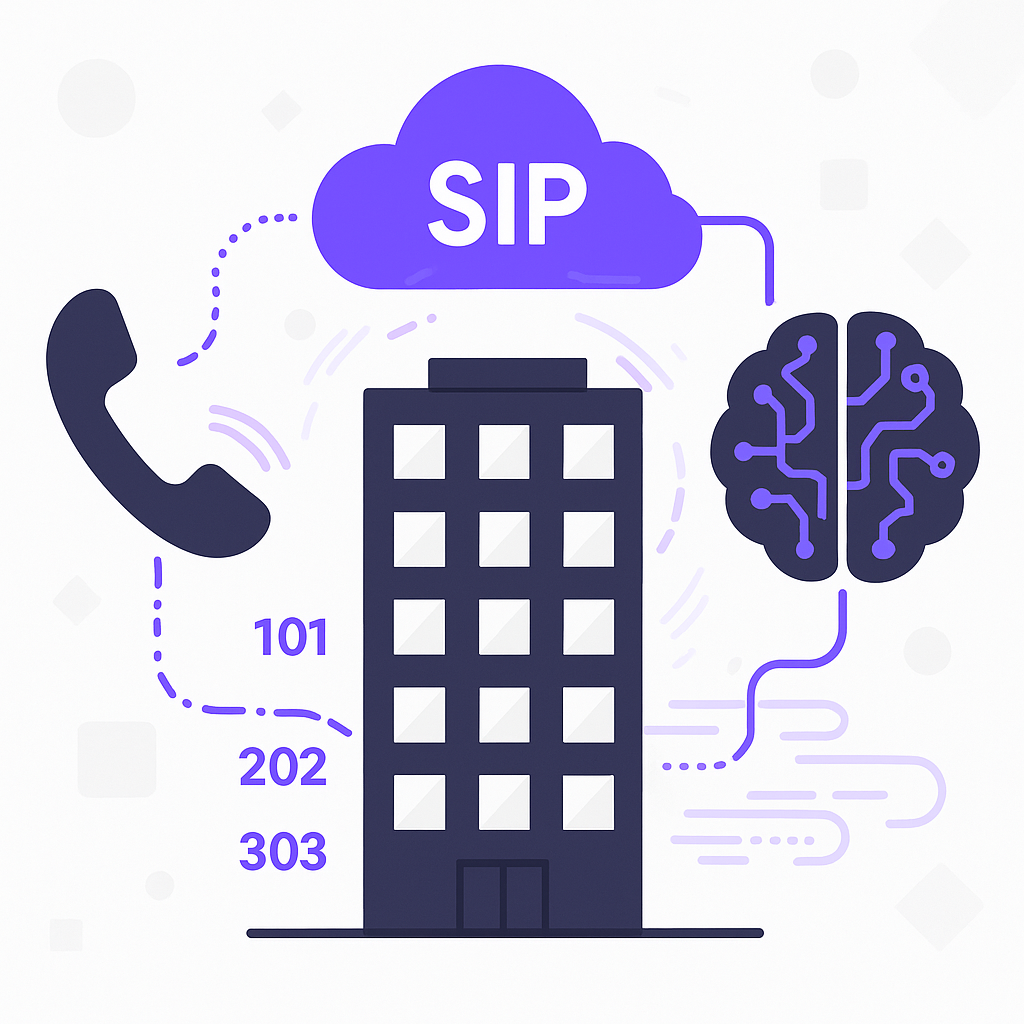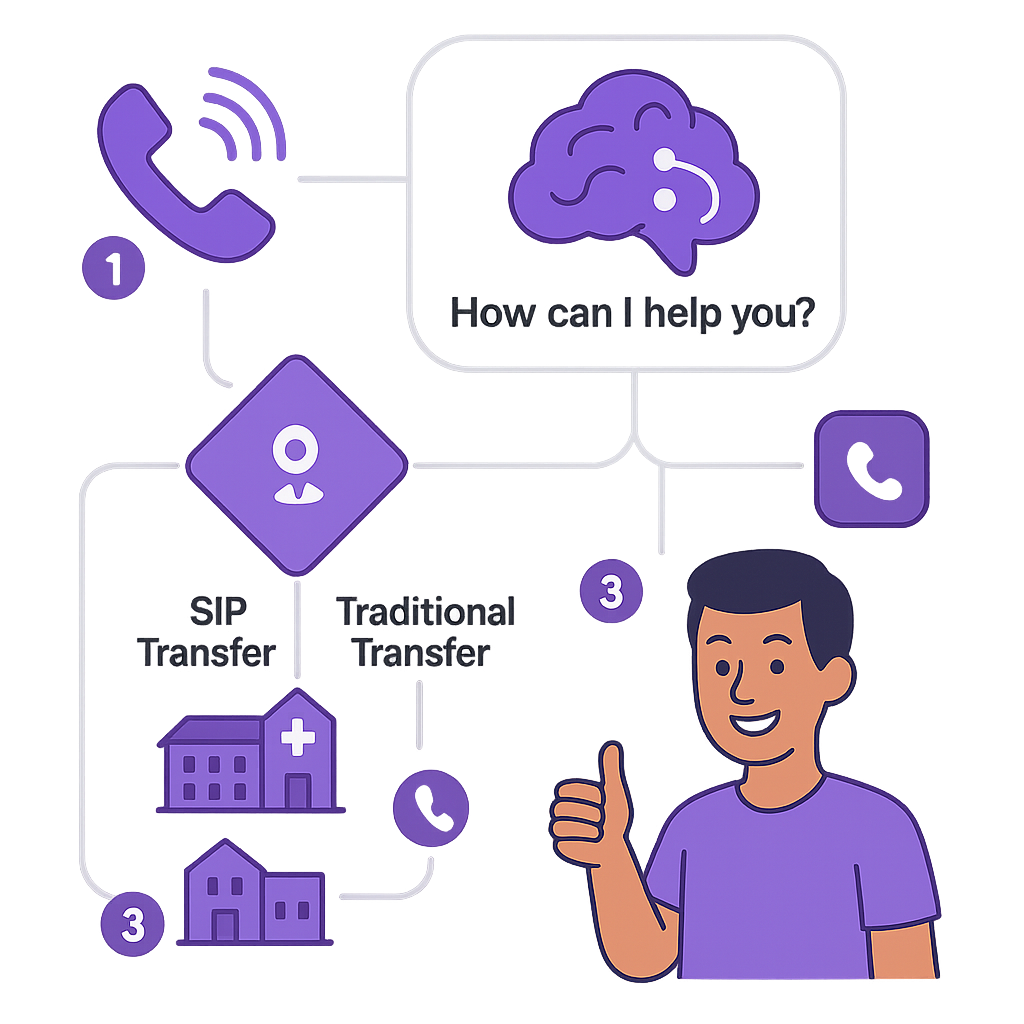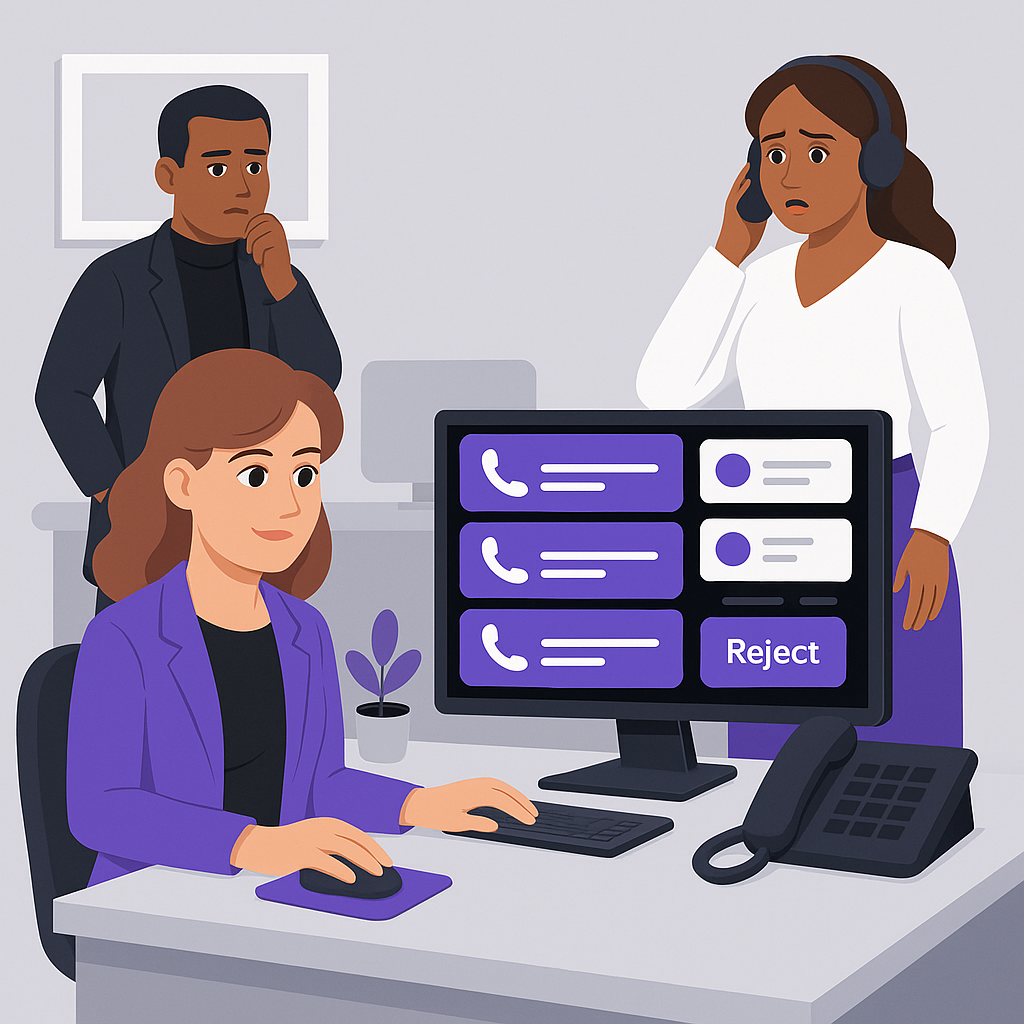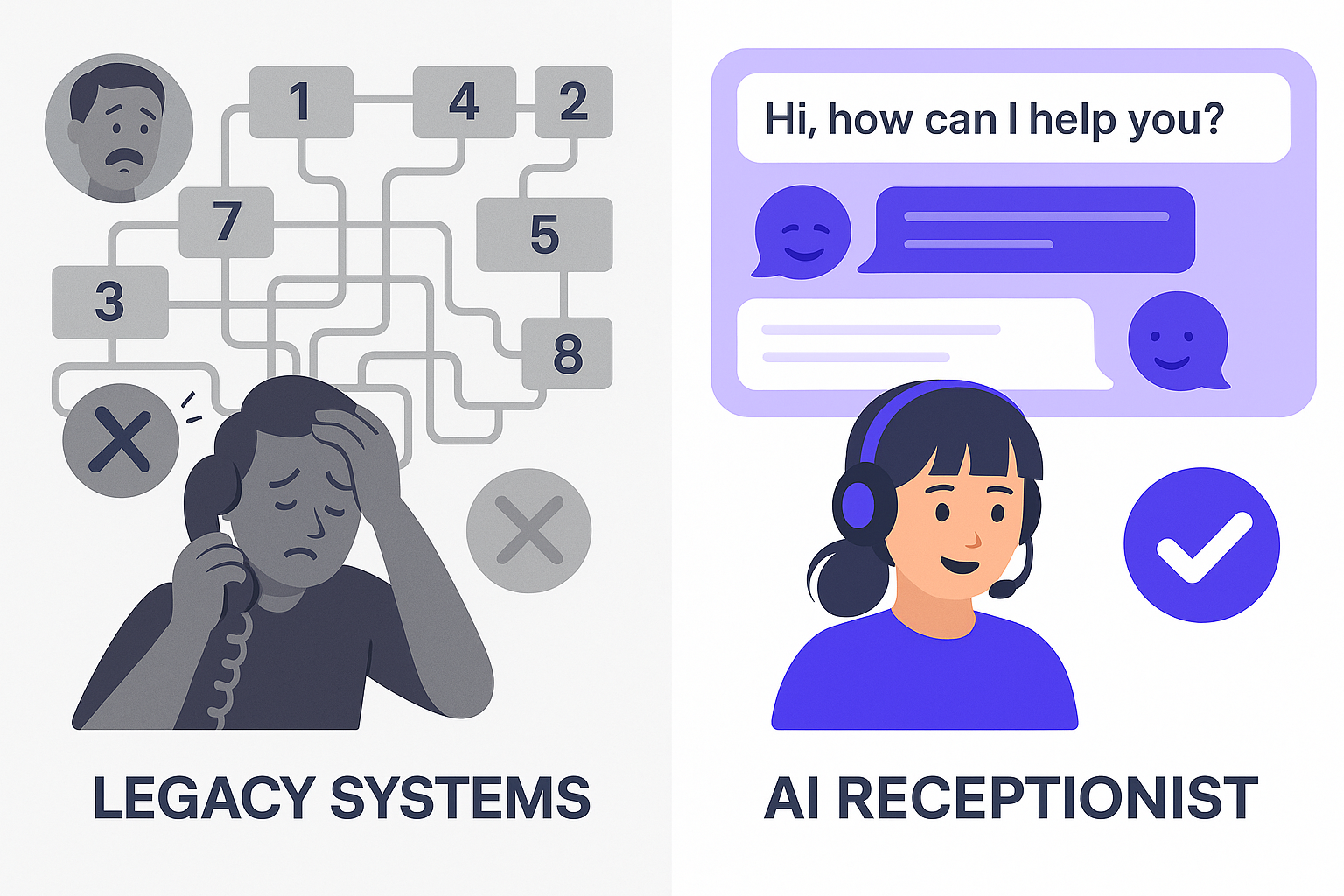Connect Your AI Receptionist to Your Existing Phone System: SIP Integration Now Available
If your organization uses a business phone system such as 3CX, FreePBX, Cisco Unified Communications, or any SIP-compatible platform, you can now integrate our AI receptionist directly into your VoIP infrastructure. No expensive hardware upgrades required.
This breakthrough represents a fundamental shift in how businesses can modernize their communication systems without the disruption and cost of complete infrastructure replacement.
What Is SIP Integration?
SIP (Session Initiation Protocol) is the standard that powers most modern business phone systems and VoIP providers. Think of it as the universal language enabling phone networks, cloud PBXs and digital systems to talk seamlessly.

When a caller reaches your business number, our AI receptionist can now transfer that call directly to an internal extension on your VoIP system - whether on-premises, cloud-hosted, or hybrid.
Instead of routing calls via legacy carriers (which may introduce delay, cost, and complexity), SIP integration creates a direct, internet-based connection between our AI platform and your VoIP system. The result: faster call handling, higher call quality, and reduced cost.
Why This Matters for Your Business
Many schools, healthcare providers, corporate offices and multi-site businesses have already invested in VoIP platforms such as RingCentral, Zoom Phone, Nextiva and others. Switching everything out can be disruptive and costly. Our service allows you to add intelligence (AI receptionist) on top of your existing infrastructure.

A school district running 3CX across multiple campuses wanted an AI receptionist to manage routine parent calls during peak hours - but did not want to rip out their existing phone system. With SIP integration, the AI receptionist now answers calls and transfers them seamlessly to the principal's desk phone, the attendance office extension or the maintenance department extension - all while leveraging their 3CX system.
The SIP integration feature transforms how your business handles calls through three key innovations:
- SIP-First Routing: If a contact in your directory has a configured extension on your VoIP system, our AI receptionist sends the call via SIP to that extension.
- Automatic Fallback: If SIP is not available (for example, remote number or non-SIP line), calls automatically route through traditional phone lines - ensuring no lost calls.
- Extension-Based Routing: You can configure routing rules like "dial 101 for the principal", "dial 202 for the reception", etc. The AI handles the mapping and executes the transfer.
Traditional phone transfers often incur per-minute fees from carriers. SIP transfers leverage your internet connection and may reduce or eliminate those carrier minutes - especially meaningful in high-volume call centers or multi-location businesses. Additionally, digital voice over IP typically offers clearer audio than analog or older digital circuits.
Because you're using your existing VoIP system and adding an AI layer, you avoid the disruption and cost of replacing your entire phone infrastructure. This makes your communication system more flexible, modern and ready for future enhancements (e.g., AI-driven routing, analytics, call-transcription etc).
Popular VoIP Providers & SIP-Ready Systems
To help you see how this fits into the broader market, here are some of the top VoIP providers in 2025 that support SIP or bridge easily to SIP-based platforms:
- RingCentral - All-rounder, ideal for mid-to-large businesses
- Zoom Phone - Cloud native, AI-capable, a strong option for modern teams
- Nextiva - Great for growing teams, call centres, unified communications
- Vonage - Flexible, customizable, includes strong mobile/remote features
- 8×8 (8x8) - Budget-friendly global calls, solid integration
- Dialpad - AI-rich calling features, good for hybrid/remote teams
- Ooma - Simplified VoIP for small business setups; excellent for plug-and-play
If you currently use one of these providers (or a legacy SIP-based system like FreePBX, Asterisk, Cisco CUCM), you're in a strong position to deploy our AI receptionist with SIP transfers quickly.
How It Works (The Simple Version)
- A call comes into your business number.
- The AI receptionist answers and determines what the caller needs (e.g., "I'm looking for the principal's office", "I want to schedule an appointment", or "I need IT maintenance").
- Based on your configuration, the system evaluates whether to transfer via SIP (to an internal extension) or via a traditional phone line (to an external number).
- The transfer happens seamlessly - the caller experiences a smooth transition with no re-dialing or awkward delays.

All this is set up via your configuration rules and our integration team helps you connect the AI platform to your SIP trunk or PBX.
Things to Check Before Implementation
To ensure seamless integration, here are a few items to validate on your VoIP/phone system side:
- SIP trunk or extension support: Ensure your PBX or cloud-phone system allows SIP transfers and/or inbound SIP-to-extension routing.
- Extension directory mapping: You'll need a directory of internal extensions (e.g., 101, 202, 303) and which contact maps to which extension.
- Network & QoS readiness: Because you'll be transferring calls over IP, ensure your network has proper bandwidth, QoS settings, and firewall/NAT traversal configured.
- Authentication & security: SIP transfers should support username/password or certificate-based authentication to avoid unauthorized access.
- Fallback path: Confirm your setup allows a fallback route (traditional PSTN or external line) in case SIP fails or is unreachable.
- Logs and analytics: Plan to track key metrics - call volume, transfer success rate, call quality, drop rates - to monitor performance and ROI.
Who Benefits Most from SIP Integration?
While virtually any business with a VoIP system can benefit from SIP integration, this feature shines brightest for:
Educational Institutions: Schools and universities using systems like 3CX or Cisco CU can route parent calls, student inquiries, facility maintenance requests and administrative calls directly to your campus extensions - all handled first by the AI receptionist.
Healthcare Practices: Medical offices using VoIP systems can have the AI receptionist triage calls (e.g., urgent vs scheduling vs billing), then transfer directly to the appropriate clinic extension, nurse line or appointment desk - without overloading the reception desk.
Multi-Location Businesses: Companies with offices in different cities (or countries) can deploy a single AI receptionist instance that routes calls based on who the caller needs - and transfers via SIP to location-specific extensions across the corporate VoIP system.
Corporate Offices: Businesses that have invested in enterprise VoIP platforms now can add intelligent call screening and routing without replacing their entire communications stack.
Future-Ready: What's Next in VoIP + AI?
The convergence of AI and VoIP is accelerating. Some trends to watch:
- AI-driven call routing and sentiment analysis embedded in VoIP platforms.
- Deeper integration with CRM and collaboration platforms (e.g., Salesforce, Microsoft Teams, Slack).
- Global SIP coverage, multi-tenant routing and more advanced distributed routing across geographies.
- Real-time analytics dashboards showing caller intent, call outcomes, voicemail-to-text, and post-call summaries.
By deploying SIP-integrated AI receptionist today, you position your organization for this next generation of communication.
Frequently Asked Questions
Q: What existing phone systems support SIP integration?
A: Most modern VoIP systems and PBXs support SIP trunking or SIP extensions - this includes 3CX, FreePBX (Asterisk), Cisco Unified Communications Manager, RingCentral, 8×8, Nextiva, and others.
Q: Will there be downtime during deployment?
A: Typically no. We integrate with your existing VoIP platform while keeping your current phone service active, ensuring continuous call-handling while we configure and test the SIP links.
Q: Do we need new hardware?
A: Not necessarily. If your VoIP system already supports SIP trunks or extension routing, no additional hardware is usually needed. For on-prem PBXs you may need to enable or configure SIP trunks - but your endpoints and phones remain unchanged.
Q: How does cost-savings work?
A: Because calls are transferred via SIP over IP rather than routed via costly carrier channels, you reduce carrier-minute usage. Plus, automated receptionist handling reduces manual transfers and frees up your staff.
Q: Is call quality reliable over SIP?
A: Yes - as long as your network is ready (sufficient bandwidth, QoS, low latency) and your VoIP provider supports enterprise-grade SLA. SIP transfers are internet-based but in modern environments they match or exceed traditional circuits.
Try SIP Integration Risk-Free Today
We're so confident in our SIP integration capabilities - and our entire AI Receptionist platform - that we offer a 3-day free trial with no credit card required. That's right: experience the full power of VoIP-integrated AI call management without any risk or commitment.
During your trial, you'll get access to all the features that make ai-receptionist.com the smart choice for VoIP integration:
- 24/7 AI-powered call answering and intelligent routing
- Seamless SIP integration with your existing phone system
- Boss Mode for verbal summaries on demand
- Multilingual support for diverse customer bases
- Spam filtering to protect your time
- Complete call transcripts and analytics
- Direct founder support - yes, you can talk to the people who built the system
Want to see it in action first? Schedule a free custom demo and we'll show you exactly how SIP integration works with your specific VoIP setup. We'll walk through real examples, answer your questions, and help you understand how this feature can transform your business communications.
The Future of Business Communication is Intelligent Integration
For too long, businesses have had to choose between modern AI capabilities and their existing phone infrastructure. SIP integration eliminates this false choice by creating a bridge between cutting-edge artificial intelligence and proven VoIP systems.
This is what modern business communication should look like: efficient, professional, and seamlessly integrated with your existing systems. Your AI Receptionist handles the heavy lifting of answering calls, screening callers, and gathering information while working harmoniously with your VoIP infrastructure.
It's a partnership between artificial intelligence and your existing technology investments, designed to give you the best of both worlds: the efficiency and consistency of AI automation combined with the reliability and familiarity of your current phone system.
Ready to connect your AI receptionist to your VoIP system? Start your free trial today and discover how SIP integration can transform the way you handle business calls. No credit card needed, no obligation, just three days to experience the difference that intelligent VoIP integration can make.
Your phone system should enhance your AI, not limit it. With ai-receptionist.com and SIP integration, it finally can.
---


